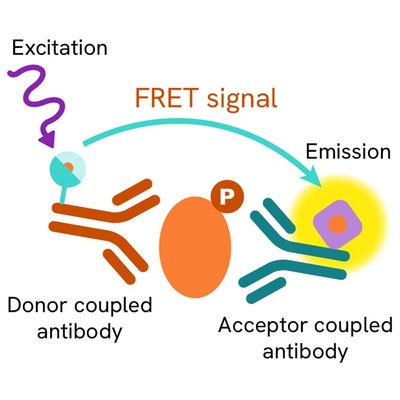

HTRF Human Phospho-AKT1 (Ser473) Detection Kit, 500 Assay Points








| Feature | Specification |
|---|---|
| Application | Cell Signaling |
| Sample Volume | 16 µL |









Product information
Overview
The phospho-AKT1 (Ser473) kit is designed for robust quantification of AKT1 modulation, phosphorylated on Ser473. Also known as protein kinase B (PKB), Akt is an oncogene playing a key role in controlling apoptosis, cell proliferation, transcription, cell migration, and glucose metabolism. AKT1 in particular plays a critical role in cell survival, and thus has important applications in cancer research.
How it works
Phospho-AKT1 (Ser473) assay principle
The Phospho-AKT1 (Ser473) assay measures AKT1 when phosphorylated at Ser473. Contrary to Western Blot, the assay is entirely plate-based and does not require gels, electrophoresis or transfer. The Phospho-AKT1 (Ser473) assay uses 2 labeled antibodies: one with a donor fluorophore, the other one with an acceptor. The first antibody is selected for its specific binding to the phosphorylated motif on the protein, the second for its ability to recognize the protein independent of its phosphorylation state. Protein phosphorylation enables an immune-complex formation involving both labeled antibodies and which brings the donor fluorophore into close proximity to the acceptor, thereby generating a FRET signal. Its intensity is directly proportional to the concentration of phosphorylated protein present in the sample, and provides a means of assessing the proteins phosphorylation state under a no-wash assay format.

Phospho-AKT1 (Ser473) 2-plate assay protocol
The 2 plate protocol involves culturing cells in a 96-well plate before lysis then transferring lysates to a 384-well low volume detection plate before adding Phospho-AKT1 (Ser473) HTRF detection reagents. This protocol enables the cells' viability and confluence to be monitored.

Phospho-AKT1 (Ser473) 1-plate assay protocol
Detection of Phosphorylated AKT1 (Ser473) with HTRF reagents can be performed in a single plate used for culturing, stimulation and lysis. No washing steps are required. This HTS designed protocol enables miniaturization while maintaining robust HTRF quality.

Assay validation
Phospho AKT1 assay: inhibitory effect of blocking peptide
SH-SY5Y cells were stimulated with human IGF-1 for 15 min. After stimulation, media was removed and cells were lysed with lysis buffer 1X for 30 min at RT under gentle shaking. 14 µL of lysates were transferred into 384-well small volume white microplates and 2 µL of different concentration of blocking peptide specific for AKT1 was added before adding 4 µL of the HTRF phospho AKT1 (Ser473) detection reagents. The HTRF signal was recorded after an overnight incubation at room temperature.

Simplified pathway
Phospho AKT1 assay: Inhibitory effect of blocking peptide
SH-SY5Y cells were stimulated with human IGF-1 for 15 min. After stimulation, media was removed and cells were lysed with lysis buffer 1X for 30 min at RT under gentle shaking. 14 µL of lysates were transferred into 384-well small volume white microplates and 2 µL of different concentration of blocking peptide specific for AKT1 was added before adding 4 µL of the HTRF phospho AKT1 (Ser473) detection reagents. The HTRF signal was recorded after an overnight incubation at room temperature.

Specifications
| Application |
Cell Signaling
|
|---|---|
| Brand |
HTRF
|
| Detection Modality |
HTRF
|
| Lysis Buffer Compatibility |
Lysis Buffer 1
|
| Molecular Modification |
Phosphorylation
|
| Product Group |
Kit
|
| Sample Volume |
16 µL
|
| Shipping Conditions |
Shipped in Dry Ice
|
| Target Class |
Phosphoproteins
|
| Target Species |
Human
|
| Technology |
TR-FRET
|
| Therapeutic Area |
Metabolism/Diabetes
NASH/Fibrosis
|
| Unit Size |
500 assay points
|
Video gallery
Citations
Resources
Are you looking for resources, click on the resource type to explore further.
Discover the versatility and precision of Homogeneous Time-Resolved Fluorescence (HTRF) technology. Our HTRF portfolio offers a...
This guide provides you an overview of HTRF applications in several therapeutic areas.
An in-depth review of molecular and cellular pathways
The maintenance of proteostasis, the biological mechanisms that control the...
Download this summary of signaling pathways in the immune system with HTRF targets.
Included:
- Detailed pathways about NK cells, T...
A comprehensive listing of Type II diabetes pathways
Type II diabetes disease cases are constantly increasing, especially for...
Study your pathway of interest in PBMC and T cells
Combine models with a technique that maximizes each one’s relevance: this note...


Loading...
How can we help you?
We are here to answer your questions.






























